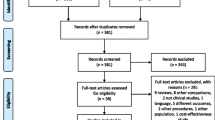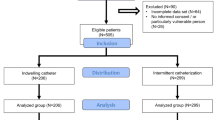Abstract
Purpose
Intermittent catheterization (IC) is a proven effective long-term bladder management strategy for individuals who have lower urinary tract dysfunction. This study provides clinical evidence about multiple-reuse versus single-use catheterization techniques and if catheter choice can have an impact on health-related quality of life (HRQoL).
Method
A prospective, multi-center, clinical trial studied patients who currently practiced catheter reuse, and who agreed to prospectively evaluate single-use hydrophilic-coated (HC) (i.e. LoFric) catheters for 4 weeks. A validated Intermittent Self-Catheterization Questionnaire (ISC-Q) was used to obtain HRQoL. Reused catheters were collected and studied with regard to microbial and debris contamination.
Results
The study included 39 patients who had practiced IC for a mean of 10 years, 6 times daily. At inclusion, all patients reused catheters for a mean of 21 days (SD = 48) per catheter. 36 patients completed the prospective test period and the mean ISC-Q score increased from 58.0 (SD = 22.6) to 67.2 (SD = 17.7) when patients switched to the single-use HC catheters (p = 0.0101). At the end of the study, 83% (95% CI [67–94%]) preferred to continue using single-use HC catheters. All collected reused catheters (100%) were contaminated by debris and 74% (95% CI [58–87%]) were contaminated by microorganisms, some with biofilm.
Conclusion
Single-use HC catheters improved HRQoL and were preferred over catheter reuse among people practicing IC. Catheter multiple-reuse may pose a potential safety concern due to colonization by microorganisms as well as having reduced acceptance compared to single use.
Trial registry number
ClinicalTrials.gov NCT02129738.

Similar content being viewed by others
References
Lamin E, Newman DK (2016) Clean intermittent catheterization revisited. Int Urol Nephrol 48(6):931–939. https://doi.org/10.1007/s11255-016-1236-9
Goetz LL, Droste L, Klausner AP, Newman DK (2018) Intermittent catheterization. In: Newman DK, Rovner ES, Wein AJ (eds) Clinical application of urologic catheters and products. Springer International Publishing, Switzerland, pp 47–77
Kessler TM, Ryu G, Burkhard FC (2009) Clean intermittent self-catheterization: a burden for the patient? Neurourol Urodyn 28(1):18–21. https://doi.org/10.1002/nau.20610
Guttmann L, Frankel H (1966) The value of intermittent catheterisation in the early management of traumatic paraplegia and tetraplegia. Paraplegia 4(2):63–84. https://doi.org/10.1038/sc.1966.7
Lapides J, Diokno AC, Silber SJ, Lowe BS (1972) Clean, intermittent self-catheterization in the treatment of urinary tract disease. J Urol 107(3):458–461
Blok B, Pannek J, Castro-Diaz D, Del Popolo G, Groen J, Hamid R, Karsenty G, Kessler TM (2018) Guidelines on neuro-urology. EAU European Association of Urology, Arnhem, The Netherlands. http://uroweb.org/guidelines/compilatios-of-all-guidelines/
Gould CV, Umscheid CA, Agarwal RK, Kuntz G, Pegues DA (2010) Guideline for prevention of catheter-associated urinary tract infections 2009. Infect Control Hosp Epidemiol Off J Soc Hosp Epidemiol Am 31(4):319–326. https://doi.org/10.1086/651091
Vahr S, Cobussen-Boekhorst H, Eikenboom J, Geng V, Holroyd S, Lester M, Pearce I, Vandewinkel C (2013) Evidence-based guidlines for best practice in urological health care catheterisation urethral intermittent in adults. European Association of Urology Nurses. Retrieved from http://nurses.uroweb.org/wpcontent/uploads/2013_EAUN_Guideline_Milan_2013-Lr_DEF.pdf
Beauchemin L, Newman DK, Le Danseur M, Jackson A, Ritmiller M (2018) Best practices for clean intermittent catheterization. Nursing 48(9):49–54. https://doi.org/10.1097/01.NURSE.0000544216.23783.bc
Chartier-Kastler E, Denys P (2011) Intermittent catheterization with hydrophilic catheters as a treatment of chronic neurogenic urinary retention. Neurourol Urodyn 30(1):21–31. https://doi.org/10.1002/nau.20929
Hedlund H, Hjelmas K, Jonsson O, Klarskov P, Talja M (2001) Hydrophilic versus non-coated catheters for intermittent catheterization. Scand J Urol Nephrol 35(1):49–53
Shamout S, Biardeau X, Corcos J, Campeau L (2017) Outcome comparison of different approaches to self-intermittent catheterization in neurogenic patients: a systematic review. Spinal Cord 55(7):629–643. https://doi.org/10.1038/sc.2016.192
Christison K, Walter M, Wyndaele JJM, Kennelly M, Kessler TM, Noonan VK, Fallah N, Krassioukov AV (2018) Intermittent catheterization: the devil is in the details. J Neurotrauma. https://doi.org/10.1089/neu.2017.5413
Rognoni C, Tarricone R (2017) Intermittent catheterisation with hydrophilic and non-hydrophilic urinary catheters: systematic literature review and meta-analyses. BMC Urol 17(1):4. https://doi.org/10.1186/s12894-016-0191-1
DeFoor W, Reddy P, Reed M, VanderBrink B, Jackson E, Zhang B, Denlinger J, Noh P, Minevich E, Sheldon C (2017) Results of a prospective randomized control trial comparing hydrophilic to uncoated catheters in children with neurogenic bladder. J Pediatr Urol. https://doi.org/10.1016/j.jpurol.2017.06.003
Chartier-Kastler E, Amarenco G, Lindbo L, Soljanik I, Andersen HL, Bagi P, Gjodsbol K, Domurath B (2013) A prospective, randomized, crossover, multicenter study comparing quality of life using compact versus standard catheters for intermittent self-catheterization. J Urol 190(3):942–947. https://doi.org/10.1016/j.juro.2013.04.026
Saadat SH, Shepherd S, Van Asseldonk B, Elterman DS (2018) Clean intermittent catheterization: single use vs reuse. Can Urol Assoc J 13:64. https://doi.org/10.5489/cuaj.5357
Håkansson MA (2014) Reuse versus single-use catheters for intermittent catheterization: what is safe and preferred? Review of current status. Spinal Cord 52(7):511–516. https://doi.org/10.1038/sc.2014.79
Sun AJ, Comiter CV, Elliott CS (2018) The cost of a catheter: an environmental perspective on single use clean intermittent catheterization. Neurourol Urodyn 37(7):2204–2208. https://doi.org/10.1002/nau.23562
Patel DN, Alabastro CG, Anger JT (2018) Prevalence and cost of catheters to manage neurogenic bladder. Curr Bladder Dysfunct Rep. https://doi.org/10.1007/s11884-018-0483-2
Pinder B, Lloyd AJ, Nafees B, Elkin EP, Marley J (2015) Patient preferences and willingness to pay for innovations in intermittent self-catheters. Patient Prefer Adher 9:381–388. https://doi.org/10.2147/PPA.S73487
Pinder B, Lloyd AJ, Elwick H, Denys P, Marley J, Bonniaud V (2012) Development and psychometric validation of the intermittent self-catheterization questionnaire. Clin Ther 34(12):2302–2313. https://doi.org/10.1016/j.clinthera.2012.10.006
Fisher H, Oluboyede Y, Chadwick T, Abdel-Fattah M, Brennand C, Fader M, Harrison S, Hilton P, Larcombe J, Little P, McClurg D, McColl E, N’Dow J, Ternent L, Thiruchelvam N, Timoney A, Vale L, Walton K, von Wilamowitz-Moellendorff A, Wilkinson J, Wood R, Pickard R (2018) Continuous low-dose antibiotic prophylaxis for adults with repeated urinary tract infections (AnTIC): a randomised, open-label trial. Lancet Infect Dis 18(9):957–968. https://doi.org/10.1016/s1473-3099(18)30279-2
Averbeck MA, Krassioukov A, Thiruchelvam N, Madersbacher H, Bogelund M, Igawa Y (2018) The impact of different scenarios for intermittent bladder catheterization on health state utilities: results from an internet-based time trade-off survey. J Med Econ. https://doi.org/10.1080/13696998.2018.1486846
Avery M, Prieto J, Okamoto I, Cullen S, Clancy B, Moore KN, Macaulay M, Fader M (2018) Reuse of intermittent catheters: a qualitative study of IC users’ perspectives. BMJ Open 8(8):e021554. https://doi.org/10.1136/bmjopen-2018-021554
Acknowledgements
In addition to the authors, the following persons from the clinical study group were essential for the conduct of this study; S Ryan, and L Bossa (Spinal and Rehabilitation Medicine, Prince of Wales Hospital Spinal Unit, Randwick), B Kimmel (Penn Center for Continence and Pelvic Health, Philadelphia) RC O’Connor and H Engelke (Froedtert Medical College and Specialty Clinic, Division of Urology, Milwaukee), RL Clark and P Patterson (North Idaho Urology, Division of Urology, Coeur D’Alene), E Chung and I Oleinikova (Department of Urology, Princess Alexandra Hospital, Brisbane). M Åström (StatCons, Sweden) contributed towards statistical analyses and guidance. Employees of Wellspect, e.g. L Gustafsson, O Sigfridson, L Berggren, N McCormick, G King have all supported in the planning, conduct and reporting of the study.
Funding
The study was funded by Wellspect HealthCare, DENTSPLY IH AB (Sweden).
Author information
Authors and Affiliations
Corresponding author
Additional information
Publisher's Note
Springer Nature remains neutral with regard to jurisdictional claims in published maps and institutional affiliations.
Electronic supplementary material
Below is the link to the electronic supplementary material.
Rights and permissions
About this article
Cite this article
Newman, D.K., New, P.W., Heriseanu, R. et al. Intermittent catheterization with single- or multiple-reuse catheters: clinical study on safety and impact on quality of life. Int Urol Nephrol 52, 1443–1451 (2020). https://doi.org/10.1007/s11255-020-02435-9
Received:
Accepted:
Published:
Issue Date:
DOI: https://doi.org/10.1007/s11255-020-02435-9




